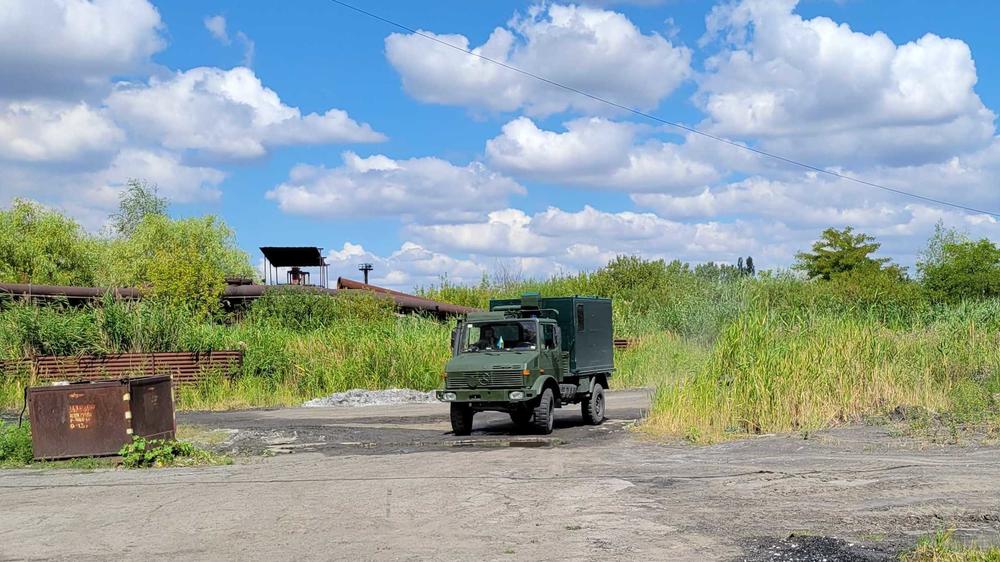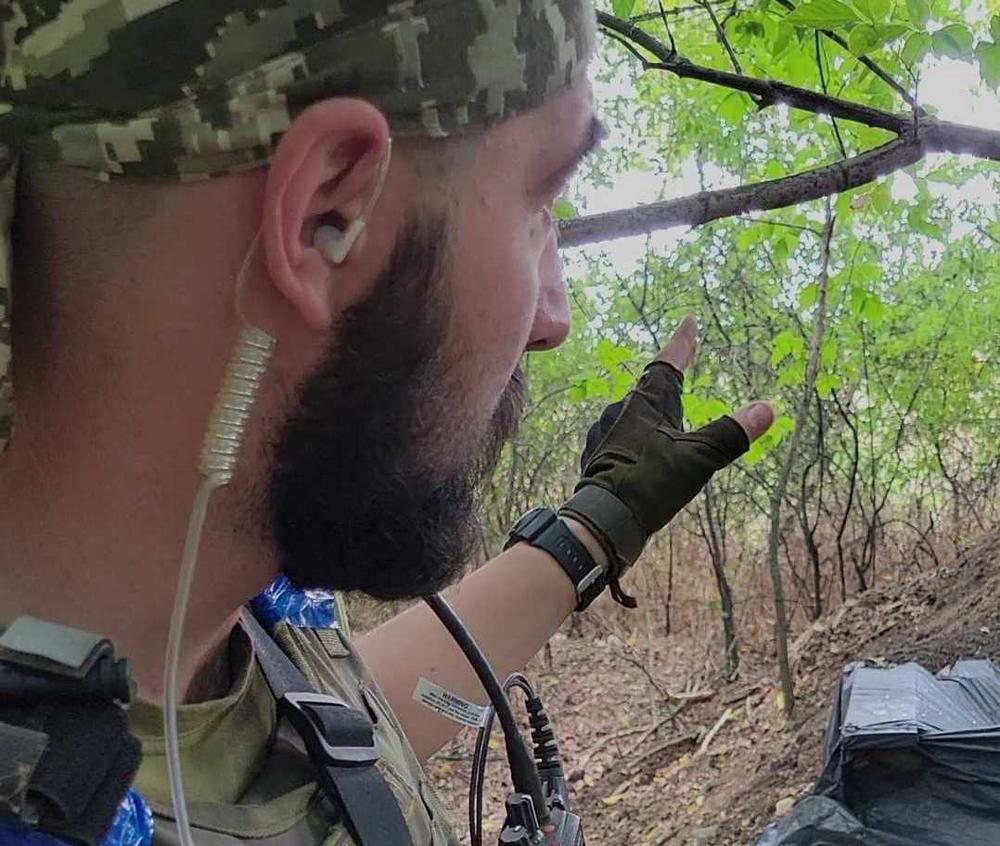Section Branding
Header Content
In the 'gray zone' outside Kherson, Ukraine's soldiers pay a terrible price
Primary Content
NEAR KHERSON, Ukraine — On a hot summer afternoon, NPR was interviewing soldiers near the front lines northeast of Kherson, when something happened that shows how perilous this sprawling combat zone can be.
Two Ukrainian fighters, who identified themselves only by their first names, Viktor and Serhiy, said they had detected a Russian drone overhead.
We were in a dense stand of forest, sheltered by the tree canopy. But the drone was apparently watching our location, possibly sharing our position with Russian artillery or other units.
"It's hovering above us as we speak," Viktor said. "It's nearby, while we are here. It's gonna fly away and then we can go back."
It was a terrifying moment. For the first time, we felt some part of the fear experienced every day by thousands of Ukrainian soldiers since Russia's invasion.
We would soon learn that in this deadly place, which some Ukrainians call "the gray zone," danger can come in many forms.
The effort to retake Kherson is Ukraine's first major counter-offensive against Russia
That morning, NPR's team set out from Kryvyi Rih, a fortified Ukrainian city in the east that often comes under Russian missile fire.
Our goal was to meet and talk to soldiers taking part in the first major counter-offensive against Russia: an effort to retake the strategic transport hub of Kherson.
Our first stop was an abandoned factory where a burly man with a dense black beard waited in the back of a Ukrainian army ambulance. Calling himself "Doc," he thumped the medical supplies strapped to his body armor. "I carry everything I need on me," he said.
Like many Ukrainian soldiers, Doc agreed to be interviewed only if NPR would use a nickname.
On this day, he was waiting. There were no patients at this hour, only the distant rumble of Russian tank fire. Doc said when wounded soldiers do come to this rendezvous point, they're often in "a very bad state," injured by the enemy's fearsome artillery.
"We need to quickly give them injections, stabilize them," he said.
From this remote outpost, the wounded are then rushed in his ambulance or other vehicles to military hospitals for further care.
According to British and U.S. intelligence reports, fighting at the Kherson front in southern Ukraine along the Dnipro River is already intense and brutal. For the first time, the Ukrainian army is trying to retake a major city, one occupied by Russia since the early days of the invasion.
Much of the fighting is being done by soldiers who were civilians not too long ago.
Asked what he expects to happen as Ukraine's first major counteroffensive pushes toward Kherson, Doc shrugged and gestured at the waiting stretchers.
"Definitely there will be more casualties," he said.
Why Kherson matters
A victory here could change the trajectory of the war.
It would demonstrate Ukraine's capacity to wield high-tech Western artillery effectively, while using ground troops to take and hold key territory.
Losing Kherson, a key bridge crossing and regional government center on the Dnipro River, would also strike a major blow to Moscow's official narrative that the war is a "limited" military operation, which Russia still claims to be winning.
A short drive from the ambulance station brought us closer to active fighting. The thump of Russian tank fire sounded more often, like a distant summer thunderstorm.
Even Ukrainian soldiers who've been fighting here for months say the "gray zone" is a vast, confusing place. It stretches in a rough arc from war-torn villages on the outskirts of Kryvyi Rih, roughly 100 miles north of Kherson, to Mykolaiv, a city near the Black Sea.
The line of active combat between Ukrainian and Russian units shifts daily, as troops move through old industrial sites, half-abandoned villages, farm fields, winding rivers and dense forests.
Russian units are still punching back
Our next stop was a heavily damaged bunker and observation post that had to be abandoned recently because of incoming Russian artillery and missile fire.
"They started off by hitting us with BM-27 Uragan," Maj. Oleksandr Lytvynov said, referring to a powerful Soviet-era rocket launcher known as a "Hurricane."
"Then a missile hit this wall from the other side. When they hit us the second time, we made the decision to relocate."
Climbing down into to a bomb crater a dozen yards across, he laughed and said he was lucky to have survived. The Russians' aim was just a little off.
Before the war, Lytvynov - a man in his mid-50s - worked outside Ukraine as a chauffeur but like many Ukrainian men he returned home to fight. He told us he volunteered to escort us closer to the fighting because it was important for people to know what life is like for Ukrainian soldiers.
"Next location," he said, holding open the door to a battered SUV.
From this point forward, Ukraine's military required NPR's team to ride in their vehicles as part of a two-car convoy.
Mile by mile, the countryside looked ever more eerily empty - farm buildings pocked by artillery, fields and roads torn by bomb craters. As the cars bounced and jarred down rutted country lanes, Lytvynov told us through an interpreter it's easy to get lost here.
Soldiers in the gray zone face constant anxiety because of Russian spotter drones, snipers and artillery.
Lytvynov pointed to farm fields where the bronze-yellow wheat will go unharvested this year because of the ever-present danger.
A trench where Ukrainians held out against Russian tanks
After a 20-minute drive, the vehicles turned into a camouflaged parking area in a line of trees. Ukrainian soldiers manned this area during some of the fiercest weeks of fighting.
"Our company held and fought here, our grunts lived here, and this is still our fallback position," said a Ukrainian soldier who identified himself by his first name Viktor.
"There was a lot of incoming. We were hit by tanks and mortars."
On foot, Viktor led the way deeper into the trees, where his fellow soldiers had dug their trench roughly 10 feet deep into the raw earth, roofing it with logs cut from the nearby forest. It was a narrow space, cramped and claustrophobic.
He said troops were often stationed here for a month at a time.
"Of course it is scary when you are under fire," said another soldier, who identified himself as Serhiy. "These feelings differ from person to person. There are people who are scared, but we also have men able to overcome this feeling."
In recent weeks, Ukraine's army pushed the Russians back from this point. It's been a grudging, bitter fight. One officer interviewed by NPR compared the fighting here to what the U.S. encountered during some of the toughest battles of Vietnam.
Despite the risk and the hardship, these soldiers seemed confident Ukraine's counteroffensive to retake Kherson will succeed.
"We are moving forward and planning to move forward more," Viktor said. "Like that, bit by bit, we move."
A Russian drone and a death in the gray zone
But it was at this moment, as the soldiers spoke confidently of Ukraine's progress pushing Russia back, that the enemy drone appeared overhead. After a few minutes' anxious wait, the soldiers led NPR's team quickly back through the forest to the cars.
We scrambled into the vehicles and left in a rush. Lytvynov, the former chauffeur who volunteered to fight and serve as our escort, drove fast over the rutted road, gripping the SUV's steering wheel.
Then he suddenly lost control. The military SUV slewed into a wheat field and then over-corrected, veering into the woods and slamming against a tree. Two members of NPR's team were injured in the crash. Lytvynov was pronounced dead at the scene by the Ukrainian military.
Ukrainian soldiers and medics — including Doc, the field medic we met earlier in the day — would help evacuate us from the grey zone to a military hospital a safe distance away.
Later, Ukrainian authorities investigating the incident said they believed the accident occurred after the SUV came under attack by Russian mortars or artillery.
NPR's team didn't hear or see hostile fire. What we did observe firsthand is how swiftly things change in this confusing, often frightening combat zone. On a summer afternoon, a stretch of forest or farm field or a village road can turn deadly almost without warning.
We also saw the terrible price Ukrainian soldiers, like Oleksandr Lytvynov, are paying as they struggle to push Russia's army out of their territory.
Copyright 2022 NPR. To see more, visit https://www.npr.org.





